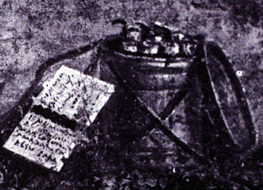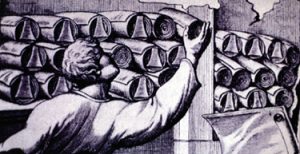Philodemus Project
 When Mount Vesuvius erupted in 79 A.D., it buried two towns. One of these was Pompeii, now among the most familiar archaeological sites in the world. The other was Herculaneum, a seaside resort which was home to the villas of wealthy Romans who would come to the beautiful Bay of Naples to escape the heat and hubbub of the capital. Herculaneum has proved difficult to excavate, buried as it is beneath ca. 20 meters of concrete-like material, the hardened volcanic mud which covered it 2,000 years ago and to whose thickness subsequent lava flows have added. Early excavations in the city were conducted by digging wells and tunnels into this rock and exploring for ancient treasures.
When Mount Vesuvius erupted in 79 A.D., it buried two towns. One of these was Pompeii, now among the most familiar archaeological sites in the world. The other was Herculaneum, a seaside resort which was home to the villas of wealthy Romans who would come to the beautiful Bay of Naples to escape the heat and hubbub of the capital. Herculaneum has proved difficult to excavate, buried as it is beneath ca. 20 meters of concrete-like material, the hardened volcanic mud which covered it 2,000 years ago and to whose thickness subsequent lava flows have added. Early excavations in the city were conducted by digging wells and tunnels into this rock and exploring for ancient treasures.
In 1752 workers tunneling into a large, wealthy villa which would have overlooked the Bay in antiquity discovered a large number of what appeared to be sticks of charcoal, some of them bundled together. Upon closer inspection, these sticks proved to be rolls of the ancient writing material papyrus. Numerous attempts to open these rolls and read their contents failed, due to their extreme fragility and the fact that they were burnt by the ca. 300 degree Celsius volcanic flow, compressed by the weight of rubble and mud, and congealed by water. Eventually, several hundred of the rolls were partly cut apart and partly unrolled. Most turned out to be works of Epicurean philosophy, with books by the first century B.C. Epicurean philosopher Philodemus of Gadara, who came to Italy around 80 B.C., especially well represented. Apparently, the Villa of the Papyri contained an extensive library, a significant part of which was formed by a library of Epicurean texts, some of which were present in more than one copy.
The difficulties involved in unrolling, reading, and interpreting these texts were formidable. Naples was not a particularly hospitable destination for classical scholars. Finally, the philosophies of the Hellenistic schools were neither well-known nor highly regarded until quite recently. These factors combined to cripple scholarly interest in and use of the Herculaneum papyri. Recently, however, in part due to the efforts of the International Center for the Study of the Herculaneum Papyri, these rolls have been the object of renewed scholarly work and have yielded many findings indispensable for the study of Hellenistic philosophy.
The Philodemus Project is an international effort which aims, supported by a major grant from the National Endowment for the Humanities and by the generous contributions of individuals and participating universities, to reconstruct new texts of Philodemus’ works on Poetics, Rhetoric, and Music. These texts will be published, along with translations and notes, in a series of volumes by Oxford University Press.
The Project’s Directors are David Blank (UCLA), Richard Janko (University College, London) and Dirk Obbink (Christ Church, Oxford). Individual texts in the series are also being edited and translated by David Armstrong (University of Texas, Austin), Robert Gaines (University of Maryland, College Park), James Porter (University of California, Irvine), and Costantina Romeo (Sorrento). Other participants in the Project include Daniel Delattre (C.N.R.S.) and Michael Wigodsky (Stanford).
The Project’s first puboished volumes are: On Poems I, edited and translated by Richard Janko (Oxford 2000)
On Poems 3-4, with fragments of Aristotle’s On Poets, edited and translated by Richard Janko (Oxford 2010)
Subsequent volumes are in the works, including:
On Poems V, edited and translated by David Armstrong, James Porter, Jeffrey Fish, and Cecilia Mangoni
On Rhetoric I-II, edited and translated by David Blank
On Rhetoric VIII, edited and translated by David Blank
On Rhetoric III, edited and translated by Dirk Obbink and Juergen Hammerstaedt

Mount Vesuvius as seen from the North side of the Bay of Naples. Herculaneum is at the foot of the mountain, toward the left. In the left middle-ground is the Castel dell’Ovo, constructed in 1154 on the island of Megaris, where the first Greek settlement at Naples, ‘Parthenope’, was founded; in Philodemus’ day Lucullus had his villa on this island.
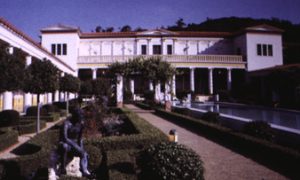 The J. Paul Getty Museum in Malibu, a modern version of the Villa of the Papyri at Herculaneum.
The J. Paul Getty Museum in Malibu, a modern version of the Villa of the Papyri at Herculaneum.
 Plans of the still-buried Villa by Swiss engineer Karl Weber, drawn on the basis of tunnels dug into the Villa in the early 1750’s.
Plans of the still-buried Villa by Swiss engineer Karl Weber, drawn on the basis of tunnels dug into the Villa in the early 1750’s.
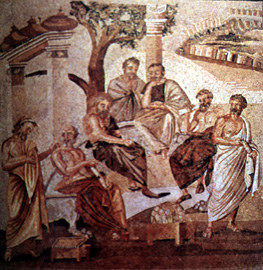 A detail from a Pompeian mosaic shows a meeting of philosophers. Such meetings were held in the villas of prominent Romans, and Philodemus will certainly have participated in some of them; they may also have been held in the Villa of the Papyri at Herculaneum.
A detail from a Pompeian mosaic shows a meeting of philosophers. Such meetings were held in the villas of prominent Romans, and Philodemus will certainly have participated in some of them; they may also have been held in the Villa of the Papyri at Herculaneum.
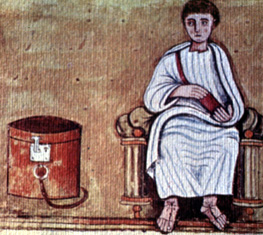 A 5th century portrait of Virgil with capsa or travelling box for papyri.
A 5th century portrait of Virgil with capsa or travelling box for papyri.
A detail from a Pompeian fresco shows an open capsa. Some papyri were found in such a box near the entrance to the long peristyle of the Villa’s garden. Perhaps there was an attempt to remove these papyri to safety before they were buried by the volcanic mud.
A now long lost relief from Trier shows a shelf of papyrus rolls (4th century). Wooden shelves holding papyri were found in one of the rooms just inside the entrance to the Villa from the long peristyle.


